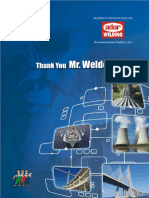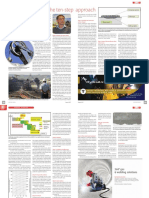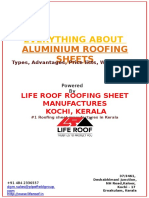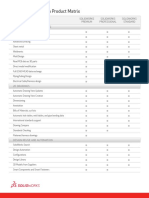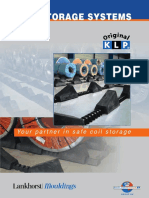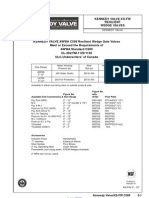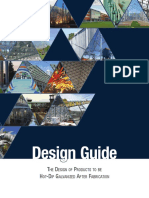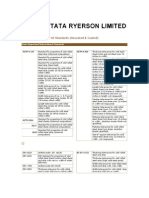Cold Galvanization
Uploaded by
Rathinavel SubramanianCold Galvanization
Uploaded by
Rathinavel SubramanianFREQUENTLY ASKED QUESTIONS ********************************* 1.What exactly is Cold galvanizing? Q. A. Q. A. Q. A.
Cold galvanisation is an organic, single-component zinc coating of minimum 92% (weight) zinc in the dry layer.
2.Is it a Paint?
No, it gives the same cathodic protection as hot dip galvanizing, but it is applied as a paint.
3. Does it have to be mixed with other products?
No, the cold galvanisation product is a single component. It requires no mixing with other chemicals to make it cure.
Q. A. Q. A.
4.If it is not a paint, what can it be compared to?
It can be compared with hot-dip galvanizing, although, weight for weight, it out-lasts hot-dip.
5.How is it not a paint if it is a liquid?
Cold galvanizing is applied as a paint but does not behave like a paint e.g. it does not skin over in the tin, it does not clogup spray-gun nozzles, it does not form loose runs easily, it does not go blotchy in damp conditions, and it does not go onto surfaces and remain wet like paint does. It also does not go on tacky like paint.
Q.
6.Does cold galvanising give the same lifetime expectation as hot dip galvanizing?
: +.32(0)81/83.42.77 : +32(0)81/83.43.39 Web site : www.rustanode.com E-mail: info@bioprotect.be 1 RA FAQ Eng 3
A. Q. A.
Yes, it does give the same lifetime expectation as hot dip galvanising. It last even 3 times longer under water.
7.Does Cold Galvanising contain the same solvents as paints?
No, the cold galvanising product Rust-Anode is a natural solvent extracted from citrus fruit (orange peelings). It even smells like orange.
Q. A.
8.Does this natural solvent contain toxic solvents used in paint?
No, the cold galvanising product Rust-Anode does not contain any organic solvent such as xylene, benzene, toluene, butyl acetone, methylene-chloride nor MEK methyl-ethylketone regularly used for the fabrication of normal paint.
Q. A.
9.How does cold galvanizing work?
The cold galvanising acts as an active coupling to the steel parent metal to form an electrolytic bond, which results in a potential of 1060mV.
Q. A.
10.What if the cold galvanizing layer is scratched through to the bare metal?
The cold galvanising gives a cathodic protection up to a 4mm scratch, this surface will often show a light brown-grey colour.
Q. A.
11.Does cold galvanizing degrade as hot dip galvanizing?
Yes, the cold galvanizing acts as hot dip galvanizing. The surface will show a white-grey powder containing zinc salts and zinc carbonates. This will cause a consumption of the zinc layer. The "corrosion" speed of this will determine the lifetime expectation of this cathodic protection.
: +.32(0)81/83.42.77 : +32(0)81/83.43.39 Web site : www.rustanode.com E-mail: info@bioprotect.be 2 RA FAQ Eng 3
Q. A.
12.What is the lifetime expectation in urban atmosphere (big city)?
The lifetime expectation is depending on the thickness of the zinc layer. If we have a normal 80m thickness than one can expect a lifetime of 25 to 30 years.
Q. A.
13.Can we increase the expected lifetime of the cold galvanizing?
Yes, the lifetime can be increased considerably by protecting the cold galvanisation with a top coating. Similar to the protection of hot dip galvanizing. This is called a duplex system, a cathodic protection and a passive protection (a paint). This can increase the initial lifetime with 2 to 3 times the initial lifetime. (See graphic British Standards)
Q. A.
14. Do we have to grit blast the cold galvanizing before applying a paint (as duplex protection)
No, one can apply directly after hardening of the cold galvanizing the paint no special blasting is required. Curing time of the zinc layer is to be respected, see technical data sheet.
Q. A.
15. Can we apply any paint on top of the cold galvanising?
No, one should use a compatible paint. See technical data sheet or ask your supplier. Never apply petrol derivates e.g. tarred products.
Q. A.
16. What is the surface preparation before applying cold galvanizing?
The surface of the steel must be clean to Sa 2 1/2 and have a roughness degree of about Ra 12. The surface must be chemical clean and free from grease, oil, silicone etc.
Q.
17.Can we apply cold galvanizing on top of a paint?
: +.32(0)81/83.42.77 : +32(0)81/83.43.39 Web site : www.rustanode.com E-mail: info@bioprotect.be 3 RA FAQ Eng 3
A.
Yes, but this doesn't make sense. Because there is no direct contact with the parent steel surface there will be no cathodic protection, the cold galvanisation will only give a passive paint protection.
Q. A.
18.Is this cheaper than hot dip galvanizing?
Yes, because one can apply it in the paint shop with the same spraying equipment used for normal paints. Extensive tests have been done to compare cold galvanisation with hot-dip, paint and metal spraying. Spread sheets showing the different price comparisons are available.
Q. A.
19.Can we apply cold galvanising on top of old and new hot dip galvanisation?
Yes, this is the only way of restoring the old cathodic protection of old hot-dip layers. The surface has to be cleaned from loose rust and dirt. A high-pressure water wash or steam cleaning will be sufficient as surface preparation.
Q. A.
20.Can we apply cold galvanisation on light rusted steel?
Yes, cold galvanisation will form a layer of iron hydroxide between the steel surface and the Rust-Anode; this layer will act as a rust inhibitor (transformer) preventing therefore any rust formation. The cathodic action will not be damaged.
Q. A.
21.Does cold galvanisation offers a fire protection?
No, cold galvanisation does not provide any fire protection. Nevertheless a dry cold galva layer will not propagate, cause or spread a fire. A compatible intumescing topcoat is the solution.
Q.
22.Has a cold galva good mechanical property?
: +.32(0)81/83.42.77 : +32(0)81/83.43.39 Web site : www.rustanode.com E-mail: info@bioprotect.be 4 RA FAQ Eng 3
A.
Yes, cold galvanisation will provide an excellent mechanical property; it has been used for Ro Ro terminals, chains, jetty's and machinery. The resin that hold the zinc allows the zinc to "move" with the structure without cracking nor peeling off. It will resist extreme distortion.
Q. A.
23.Can you weld stud bolts on beams with cold galvanisation?
Yes, on 40m one can easily make the welds. On 40m one can make normal welds with rods or MIG with X-ray quality can be done without porosities. Cold galvanisation can therefore be used as shop and welding primer and later on increased to a full 80m cathodic protection.
Q. A.
24.Can we use cold galvanisation on a wet surface?
Yes, after High Pressure water jet cleaning you can apply cold galvanisation without the need for complete drying of the surface.
Q. A.
25.Do we have to wet the surface (with fresh water) of a freshly applied cold galvanisation?
No, you don't have to do so. It certainly gives a good result, because it improves the polymerisation and the formation of zinc salts and zinc carbonates on the surface and this offers a barrier protection with a harder coating. It also helps to avoid dark spots on the freshly coated surface due to raindrops.
Q. A.
26.What is the most economical way of preparing large steel surfaces (e.g. ships)?
The most economical surface preparation and also the most environmental friendly one is the Ultra High Pressure (4.000 bar) water cleaning with the use of Almandite Garnet as abrasive.
: +.32(0)81/83.42.77 : +32(0)81/83.43.39 Web site : www.rustanode.com E-mail: info@bioprotect.be 5 RA FAQ Eng 3
Q. A.
27.How does cold galvanisation react to seawater?
Cold galvanisation is best protected with a duplex system. The most appropriate way is to use of a Mic sealer and a Pur topcoat. If the cold galvanisation is used as a single system then a water saturation of at least 2 hours before immersed into the sea is required. As mentioned elsewhere the polymerisation will speed up the formation of a barrier protection.
Q. A.
28.Can cold galvanisation be used where food is stored and handled?
Yes, cold galvanisation is when cured (hardened) non-toxic and can be used even for drinking water storage tanks. Although a sealer on top of the cold galvanisation could be recommended to improve the taste of the water.
Q. A.
29.Can cold galvanisation be used as anti-foulding on ships?
Yes, cold galvanisation provides a certain anti-foulding protection, although it hasn't been designed for this purpose. Ships intend to use a duplex system (with the appropriate colours) and a special anti-foulding with extremely low friction degree.
Q.
30.What is the difference between the traditional zincsilicate paint and cold galvanisation?
On top of the quality difference between a paint and a cathodic protection there are a number of practical differences. Zn-Si is a two-component product; cold galva is a single-component. Zn-Si require a Sa 3 standard of cleanliness, cold galva requires only Sa 2.5. .
A.
: +.32(0)81/83.42.77 : +32(0)81/83.43.39 Web site : www.rustanode.com E-mail: info@bioprotect.be 6 RA FAQ Eng 3
Thirdly, using the Zn-Si paint the surface has to be absolutely dry before applying or it cures at the interface before it cures throughout the coating. Cold galva RustAnode can be applied on wet surface, it goes onto slurryblasted (High-Pressure water/abrasive cleaning) surfaces as soon as the blasting has stopped
Q.
31.Will there be rust creeping under the cold galva layer?
No, cold galva is not a paint. The basic difference between a paint "passive" barrier and a cold galva "active" cathodic protection is that the paint barrier once breached corrosion starts and continuous underneath the paint regardless of how thick it is applied. Cold galva will remain onto the steel and even a scratch to the bare metal of 4mm wide will not rust because of the cathodic effect of the surrounding zinc layer.
Q. A.
32.What is the better quality of hot-dip galvanisation compared to cold galvanisation?
Cold galvanisation doesn't resist petrol derivates such as grease, oil, gas oil etc; if one needs a protection the a duplex system should be applied on top of the cold galvanisation layer.
Q. A.
33.Can we apply cold galvanisation in freezing storage halls?
Yes cold galvanisation can be applied in freezing temperatures with working temperatures to -40C. The binder resin will certainly become more dense (like butter) and the application with a brush or roller will be required.
Q.
34.The cold galvanisation is not a hard alloy; does this give any advantage?
: +.32(0)81/83.42.77 : +32(0)81/83.43.39 Web site : www.rustanode.com E-mail: info@bioprotect.be 7 RA FAQ Eng 3
A.
Yes, there are two advantages. The first one is that the cold galva layer has a uniform quality throughout the layer. The hot dip galva forms a number of alloy layers with different % of Zn and hardness. Secondly the dilatation gradient of the metal is 12 and the one of hot-dip zinc layer is 29. The alloy layer of hot-dip cannot follow the dilatation of the steel and will come loose from the steel surface, breaking the cathodic protection and rusting can start. The cold galva has resin as binder allowing temperature movement without coming loos from the steel.
Q. A.
35.What is the hardness of steel, zinc and the cold galva layer?
The hardness of steel is about 160Vickers, zinc (and cold galva) is about 70Vickers and the hot-dip layer alloy has a delta layer of 10m with a hardness of about 240Vickers. This means that the very hard hot dip layer is very hard and brittle. This can cause hidden corrosion problems this is not the case with the cold galva application.
Q.
36.Does the Silicium and the Phosphorus content of the steel influence the application of cold galvanisation?
No, because the cold galvanisation does not form an alloy with the steel, the Si and the P of the steel doesn't have any influence; this is not the case with hot-dip galvanisation where special attention is required for this problem.
A.
Q.
37.Can we protect concrete reinforcing steel bars (rebars) with cold galvanisation?
: +.32(0)81/83.42.77 : +32(0)81/83.43.39 Web site : www.rustanode.com E-mail: info@bioprotect.be 8 RA FAQ Eng 3
A.
Yes, the cold galvanizing is the only product that provides a corrosion protection of rebars. It is easy to apply, provides the cathodic protection and the pull out tests have given excellent results.
Q. A.
38.What is the best reason why we should use cold galvanisation instead of hot-dip galvanisation?
The lower price and the facility to apply it in the paint work shop without the inconvenience of the (thermal) problems of the hot-dip bath with restrictions on the dimensions and shape of the steel elements.
Q. A.
39.What is the maximum thickness for the cold galva layer?
Extensive testing shows that the maximum thickness is about 160m. Above this there will be no better life time expectation, although the extra "passive" protection will still provide an extra advantage. Cheaper is the use of a normal paint as topcoat.
Q. A.
40.How long does cold galvanisation exist?
The product Rust-anode exists since 1954.
---------------------------------
: +.32(0)81/83.42.77 : +32(0)81/83.43.39 Web site : www.rustanode.com E-mail: info@bioprotect.be 9 RA FAQ Eng 3
You might also like
- YUGAL NPCIL KAIGA Recruitment Application FormNo ratings yetYUGAL NPCIL KAIGA Recruitment Application Form3 pages
- The Use of Toughened Glass in ArchitectureNo ratings yetThe Use of Toughened Glass in Architecture11 pages
- Coatings For Corrosion Protection - Offshore Oil and Gas Operation PDFNo ratings yetCoatings For Corrosion Protection - Offshore Oil and Gas Operation PDF334 pages
- Manufacturing Techniques of FRP CompositesNo ratings yetManufacturing Techniques of FRP Composites34 pages
- Guidelines To Make Paper Corrugated PlantNo ratings yetGuidelines To Make Paper Corrugated Plant6 pages
- SR. NO. Particular NO. 3 Project at Glance 5 General Information 6-10No ratings yetSR. NO. Particular NO. 3 Project at Glance 5 General Information 6-1050 pages
- List of Profitable Projects On Pipe & Tubes ProductionNo ratings yetList of Profitable Projects On Pipe & Tubes Production74 pages
- Cortec India NACE - SZ and CII Sept, 2014No ratings yetCortec India NACE - SZ and CII Sept, 201470 pages
- Engineering Corrosion Protection at Hub Power Station: Tariq Aziz Nace Level 2No ratings yetEngineering Corrosion Protection at Hub Power Station: Tariq Aziz Nace Level 250 pages
- Index: 2.1 Company Layout of Menon AlkopNo ratings yetIndex: 2.1 Company Layout of Menon Alkop20 pages
- Electric Welding: Some of The Advantages of Welding AreNo ratings yetElectric Welding: Some of The Advantages of Welding Are11 pages
- B Tech Naval Architecture and Offshore Engineering0% (1)B Tech Naval Architecture and Offshore Engineering121 pages
- Amendment No. 1 January 2020 TO Is 11329: 2018 Finned Type Heat Exchanger For Room Air Conditioner100% (1)Amendment No. 1 January 2020 TO Is 11329: 2018 Finned Type Heat Exchanger For Room Air Conditioner7 pages
- Owner Michael Calistrat and Associates Missouri City, Texas100% (1)Owner Michael Calistrat and Associates Missouri City, Texas8 pages
- Concrete Repair Q & A: by Bill Scannell and Ali Sohanghpurwala100% (1)Concrete Repair Q & A: by Bill Scannell and Ali Sohanghpurwala2 pages
- Aluminium Alloys Used in The Marine IndustryNo ratings yetAluminium Alloys Used in The Marine Industry7 pages
- Conti USA IFS Hydraulic Hoses Fittings Catalog 2016No ratings yetConti USA IFS Hydraulic Hoses Fittings Catalog 2016444 pages
- Comprehensive Guide Single Girder Eot CraneNo ratings yetComprehensive Guide Single Girder Eot Crane11 pages
- Understanding About Duplex Welding Metallurgy Before Having Good Welding ProceduresNo ratings yetUnderstanding About Duplex Welding Metallurgy Before Having Good Welding Procedures15 pages
- Alignment Pitfalls - How To Identify and Eliminate Them: Before They Invest Valuable Downtime in An UnproductiveNo ratings yetAlignment Pitfalls - How To Identify and Eliminate Them: Before They Invest Valuable Downtime in An Unproductive6 pages
- Colour Coated Aluminium Roofing Sheets, Types, Prices in Kerala100% (1)Colour Coated Aluminium Roofing Sheets, Types, Prices in Kerala11 pages
- Guidance Notes For Air Lubrication Systems (2020)No ratings yetGuidance Notes For Air Lubrication Systems (2020)17 pages
- Bechem Lubricants For High Load and High TemperatureNo ratings yetBechem Lubricants For High Load and High Temperature3 pages
- Comparative Study of Aluminium Alloy Pistons ManufacturedNo ratings yetComparative Study of Aluminium Alloy Pistons Manufactured3 pages
- Indian Standard: Bonded Mineral Wool - Specification (No ratings yetIndian Standard: Bonded Mineral Wool - Specification (10 pages
- Diesel Engine Exhaust Spark Arrestors: Key Features and BenefitsNo ratings yetDiesel Engine Exhaust Spark Arrestors: Key Features and Benefits8 pages
- Qcs 2010 Part 14 Protective Treatments For Concrete100% (1)Qcs 2010 Part 14 Protective Treatments For Concrete19 pages
- Haygrove Garden Polytunnels Brochure 2011No ratings yetHaygrove Garden Polytunnels Brochure 201120 pages
- 1 Mech Malleable Iron Fittings Catalogue PDFNo ratings yet1 Mech Malleable Iron Fittings Catalogue PDF12 pages
- Proposed Buildong Dumpster: Site Plan NotesNo ratings yetProposed Buildong Dumpster: Site Plan Notes11 pages
- As 2089-2008 Sheave Blocks For Lifting PurposesNo ratings yetAs 2089-2008 Sheave Blocks For Lifting Purposes7 pages
- Kennedy - Modelo OSY 8068A y y NRS - Valvulas CompuertaNo ratings yetKennedy - Modelo OSY 8068A y y NRS - Valvulas Compuerta8 pages
- Design Guide Galvanized Steel StructuresNo ratings yetDesign Guide Galvanized Steel Structures28 pages
- Tripac Technical Data - Bolt - Wrench Sizes Chart100% (2)Tripac Technical Data - Bolt - Wrench Sizes Chart19 pages
- Coatings For Corrosion Protection - Offshore Oil and Gas Operation PDFCoatings For Corrosion Protection - Offshore Oil and Gas Operation PDF
- SR. NO. Particular NO. 3 Project at Glance 5 General Information 6-10SR. NO. Particular NO. 3 Project at Glance 5 General Information 6-10
- List of Profitable Projects On Pipe & Tubes ProductionList of Profitable Projects On Pipe & Tubes Production
- Engineering Corrosion Protection at Hub Power Station: Tariq Aziz Nace Level 2Engineering Corrosion Protection at Hub Power Station: Tariq Aziz Nace Level 2
- Electric Welding: Some of The Advantages of Welding AreElectric Welding: Some of The Advantages of Welding Are
- B Tech Naval Architecture and Offshore EngineeringB Tech Naval Architecture and Offshore Engineering
- Amendment No. 1 January 2020 TO Is 11329: 2018 Finned Type Heat Exchanger For Room Air ConditionerAmendment No. 1 January 2020 TO Is 11329: 2018 Finned Type Heat Exchanger For Room Air Conditioner
- Owner Michael Calistrat and Associates Missouri City, TexasOwner Michael Calistrat and Associates Missouri City, Texas
- Concrete Repair Q & A: by Bill Scannell and Ali SohanghpurwalaConcrete Repair Q & A: by Bill Scannell and Ali Sohanghpurwala
- Conti USA IFS Hydraulic Hoses Fittings Catalog 2016Conti USA IFS Hydraulic Hoses Fittings Catalog 2016
- Understanding About Duplex Welding Metallurgy Before Having Good Welding ProceduresUnderstanding About Duplex Welding Metallurgy Before Having Good Welding Procedures
- Alignment Pitfalls - How To Identify and Eliminate Them: Before They Invest Valuable Downtime in An UnproductiveAlignment Pitfalls - How To Identify and Eliminate Them: Before They Invest Valuable Downtime in An Unproductive
- Colour Coated Aluminium Roofing Sheets, Types, Prices in KeralaColour Coated Aluminium Roofing Sheets, Types, Prices in Kerala
- Bechem Lubricants For High Load and High TemperatureBechem Lubricants For High Load and High Temperature
- Comparative Study of Aluminium Alloy Pistons ManufacturedComparative Study of Aluminium Alloy Pistons Manufactured
- Indian Standard: Bonded Mineral Wool - Specification (Indian Standard: Bonded Mineral Wool - Specification (
- Diesel Engine Exhaust Spark Arrestors: Key Features and BenefitsDiesel Engine Exhaust Spark Arrestors: Key Features and Benefits
- Qcs 2010 Part 14 Protective Treatments For ConcreteQcs 2010 Part 14 Protective Treatments For Concrete
- Kennedy - Modelo OSY 8068A y y NRS - Valvulas CompuertaKennedy - Modelo OSY 8068A y y NRS - Valvulas Compuerta
















